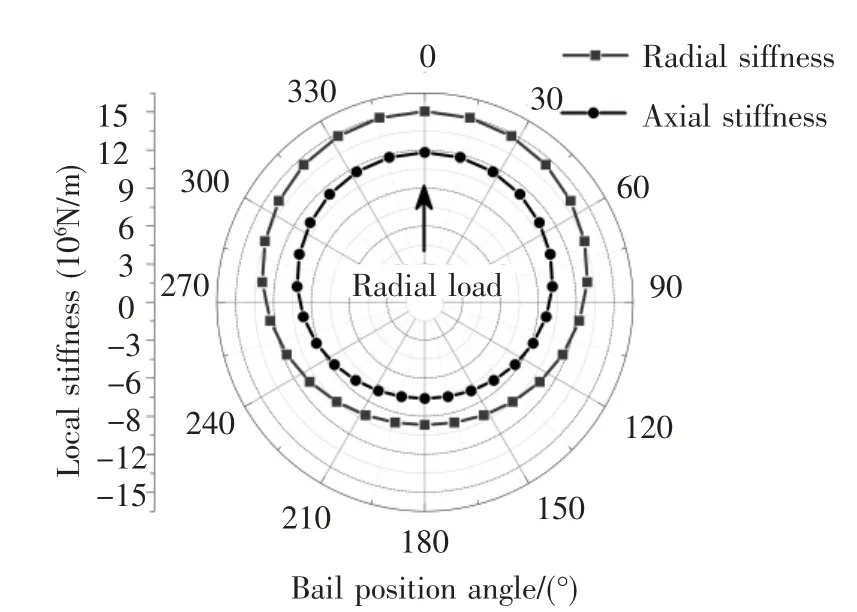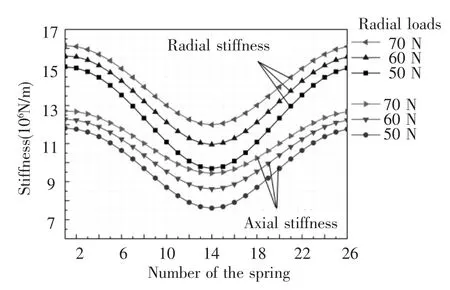Quasi Dynamic Calculation of Local Stiffness of Angular Contact Ball Bearings
2013-09-16ZhenHuanYeChuanWeiZhangLeGuLiQinWangDeZhiZheng
Zhen-Huan Ye,Chuan-Wei Zhang,Le Gu,2,Li-Qin Wang,De-Zhi Zheng
(1.School of Mechatronics Engineering,Harbin Institute of Technology,Harbin 150001,China;2.University of California,San Diego,La Jolla CA 92093-0401,USA)
1 Introduction
An enormous amount of attention has been put on the complex behaviors of ball bearings,especially to bearing stiffness,because of its significant influence on dynamic performances of rotors.
Bearing stiffness was simply calculated with static calculation method at the beginning[1].Then it was computed with the improved bearing analysis methods[2],such as,quasi static method,quasi dynamic method and dynamic method[3-5].Among them,quasi dynamic calculation method was proved to be an efficient and accurate one,and was widely used in practice[6-7].With quasi-dynamic calculation method,Alfares et al.[8]computed the stiffness of angular contact ball bearings and found out that lager initial reload could increase bearing stiffness.Wang et al.[9]calculated the dynamic stiffness of ball bearings using quasi-dynamic method.The results showed that initial contact angles and axial loads have great effects on the dynamic characteristics of bearings.
With the development of thin wall bearings on robotic and precision equipment,local bearing stiffness plays more and more important roles on bearing performance.Finite element analysis(FEA)method is widely used to calculate the local stiffness of rolling bearings in recent years[10-12],but the setup of mesh generation and boundary condition of FEA are very critical and complex.Compare with FEA method,theoretical method improves calculation efficiency without any setup technique,but most theoretical studies mainly focused on the global bearing stiffness.As the basis for calculating the local bearing stiffness,the load distribution and local contact deformation in bearings have been fully studied.Stribeck firstly studied on the contact between balls and raceways with both Hertz contact theory and test results.Then the contact within bearings have been studied increasingly[13-16],making great contribution to the static and dynamic analysis of bearings.
In this paper,the load distribution and local contact deformation in angular contact ball bearings were calculated using quasi dynamic calculation method.The calculation model of local bearing stiffness was subsequently built based on the relationship of local load to contact deformation.Effects of external loads on the local bearing stiffness were analyzed.
2 Quasi-dynamic Calculation of Local Stiffness of Ball Bearing
2.1 Modeling of Ball Bearing and Local Stiffness
Fig.1 shows the angular contact ball bearing with the global coordinate OXYZ.The outer ring is fixed,and external loads are applied onto inner ring.Balls are clockwise numbered from No.1 showed in the Figure.Each ball has its own coordinate obxbybzb,where,axis xbhas the same direction with axis X in coordinate OXYZ;direction of axis zbis from the center O to the center ob.Direction of axis ybis determined by the right-hand rule.

Fig.1 Model of angular contact ball bearing
Fig.2 shows the model of local stiffness of angular contact ball bearings.On the position of each ball,one axial and one radial spring are used to indicate the axial and radial local stiffness respectively.Springs are numbered clockwise from No.1 as shown in Fig.2.The radial and axial springs have the same number on the same position.

Fig.2 Local stiffness of angular contact ball bearing
2.2 Calculation of Local Stiffness
When external loads are transmitted from the inner ring to balls,the raceways and balls will move and deform.Fig.3 shows the contact statues between raceways and the ball numbered with j.Initial contact between the ball and raceways is shown in Fig.3(a).When the external load is supposed very little and,the deformation of balls and raceways are ignoredαj0is the initial contact angle.Fig.3(b)shows the contact status between the ball and raceways when the external loads[FxFyFz]are applied.The movement of inner raceway and the ball’s center are defined as[ ΔxΔyΔz]and[δxj0δrj]respectively.The deformation of the ball is defined asδj.αjandβjare the contact angle between the ball and raceways.αjis not equal toβjbecause of the centrifugal force of the ball during the running process.
1)Calculation of contact point movement.
When external loads are applied,the contact between ball and raceways change from initial contact status in Fig.3(a)to loaded contact status in Fig.3(b),and contact points move from Ciand Ceto C'iand C'e.The relative movements between the ball’s center and the contact points are showed in Eq.(1):

where Dbis ball diameter;αandβare contact angles between ball and inner outer raceway.The superscript of b means the local coordinate on the ball.

Fig.3 Deformation and movement of bearing ball and raceways
2)Calculation of relative displacement between inner and outer raceway.
Global relative displacement between centers of inner and outer rings is[ ΔxΔyΔz].According to that,local relative displacement between centers of inner and outer raceways in Fig.1 can be determined as:

where,Oiand Oeare centers of inner and outer raceway,respectively;θjis the position angle of the jth ball.
3)Calculation of deformation of ball and raceways.
Deformation of ball and raceways can be determined by ball movement and local relative displacement between centers of inner and outer raceways:

The relationship of contact angle to the relative movement between raceways and ball can be represented as:

where f is the race curvature factor.The subscript of i and e mean inner and outer raceway,respectively.
4)Calculation of contact load
According to Hertz contact theory,the contact loads between ball and raceways are determined by their deformation:

where E'is the equivalent elastic modulus of ball and raceways.K(e)and L(e)is the first and second elliptic integral,respectively.v is the ellipticity of the contact region.∑ρis the sum of the curvature of the ball and raceways.
The equilibrium equations of loads on the jth ball can be represented as:

where Fcis the centrifugal force of the ball.
Meanwhile,the sum of all contact loads should be equal to the external loads applied to the bearing:

5)Calculation of local bearing stiffness
Combining Eqs.(1)-(7),local deformation and load distribution in bearings are iteratively calculated.With the local deformation and load distribution,radial and axial local bearing stiffness can be calculated.Firstly,a little variation of Δδjis applied to the relative displacement between inner and outer raceways.The subsequent change of local load ΔFjwill be got.Then the radial and axial local stiffness can be calculated as follows:where the subscripts of a and r mean the axial and radial directions,respectively.

2.3 Global Stiffness of Angular Contact Ball Bearing
Global bearings stiffness can be calculated by the external loads and the relative displacement between inner and outer rings:

where∂ Δiis a little variation of relative displacement between inner and outer rings;∂Fiis the subsequent variation of external loads.
Fig.4 shows the global stiffness of the angular contact ball bearing SKF 7200AC.It was calculated using both the above method and the John-Harris method[17].The results show that,although the different oil parameters cause some difference between the stiffness values in these two methods,the variation tendency of bearing stiffness is almost the same.It means that the above quasi-dynamic calculation method can get appropriate parameters,such as,loads and deformation,for calculating local bearing stiffness.

Fig.4 Global stiffness of angular contact ball bearing SKF 7200(ω=3000 r/min)
3 Results and Discussion
An angular contact ball bearing was taken and,its local stiffness was calculated with the above method.Its geometry parameters and material properties are showed in Tables 1 and 2.

Table 1 Geometry parameters of an angular contact ball bearing

Tab.2 Material properties of an angular contact ball bearing
3.1 Local Bearing Stiffness
Fig.5 illustrates the local stiffness of the ball bearing,when the axial load is 50 N and the radial load is 20 N.The local stiffness has the maximum value on the position of 0°,and gradually decreases to the minimum value on the position of 180°.According to Eqs.(5)and(7),the relationship of local stiffness to local deformation is kj=(∂Qj/∂δj)∝The local deformation varies on different positions in bearings as the result of contact load distribution.The largest local deformation occurs on the position of 0°and the least on the position of 180°,so the local stiffness varies in different positions.

Fig.5 Local bearing stiffness(axial load:50 N;radial load:20 N)
3.2 Effects of Loads on Local Bearing Stiffness
Fig.6 shows the local bearing stiffness,when the axial load is 50 N and the radial loads are 5,10 and 20 N respectively.With the increase of radial load from 5 N to 20 N,the stiffness of upside springs(numbered 1-7 and 21-26)increases,while the stiffness of downside springs(numbered 8-20)decreases.The variation of stiffness is caused by different local deformation in the bearing.Okamoto[18]had proved that when the radial load increases,the deformation of upside balls increases and that of downside balls decreases.
Fig.7 shows the local bearing stiffness,when the radial load is 20 N and the axial loads are 50,60 and 70 N respectively.With the increase of axial load from 50 N to 70 N,the stiffness of both radial and axial springs increases.Because the increase of axial load causes the local deformation increase[18].

Fig.6 Local bearing stiffness(axial load:50 N)

Fig.7 Local bearing stiffness(radial load:20 N)
4 Conclusions
The load distribution and local contact deformation in angular contact ball bearings were calculated using quasi-dynamic calculation method.Local bearing stiffness was subsequently computed based on the relationship of local load to contact deformation.The radial and axial component of local stiffness was got,and effects of external loads on the local bearing stiffness were analyzed.
The local stiffness in bearings is symmetric to the axis of radial load.Its value has a maximum on the symmetry axis along the radial load direction and a minimum against the radial load direction.The local stiffness in bearings gradually drops from the maximum value to the minimum value.With the increase of external radial load,the maximum value increases,while the minimum value decreases.With the increase of external axial load,the local bearing stiffness increases.
[1]Wang K W,Shin Y C,Chen C H.On the natural frequencies of high-speed spindles with angular contact bearings.Journal of Mechanical Engineering Science,1991,205(3):147-154.
[2]Gupta P K.Current status of and future innovations in rolling bearing modeling.Tribology Transaction,2011,54:394-403.
[3]Hernot X,Sartor M,Guillot J.Calculation of the stiffness matrix of angular contact ball bearings by using the analytical approach.Journal of Mechanical Design,2000,22(1):83-90.
[4]Andreason S.Load distribution in a taper roller bearing arrangement considering misalignment.Tribology,1973,6(3):84-92.
[5]Gupta P K.Advanced Dynamics of Rolling Elements.New York:Springer-Verlag,1984.
[6]Khan A A,Vyas N S.Nonlinear bearing stiffness parameter estimation in flexible rotor-bearing systems using Volterra and Wiener approach.Probabilistic engineering Mechanics,2001,16:137-157.
[7]Cui Li,Zheng Jianrong,Wang Liqin.Study on dynamic characteristics of ball bearings and rotor system considering coupling effects.China Mechanical Engineering,2010,21(18):2233-2237.(in Chinese)
[8]Alfares M A,Elsh Arkawy A A.Effects of axial preloadingof angular contact ball bearings on the dynamics of a grinding machine spindle system.Journal of Materials Processing Technology,2003,136(1):48-59.
[9]Wang Liqin,Cui Li,Zheng Dezhi,et al.Study on dynamic property of ball bearing system with nonlinear vibration of rotor.Journal of Mechanical Engineering Science.2008,222(9):1811-1819.
[10]Chen Shuquan,Xiao Shuhong,Yang Shitie.Analysis on contact performance of angular contact ball bearings.Bearing,2009(11):4-7.(in Chinese)
[11]Shi Shicai,Wu Jianwei,Li Rong,et al.Axis stiffness analysis of thin-section angular contact ball bearing and its experiment.Journal of Harbin Institute of Technology.2012,44(7):32-37.(in Chinese)
[12]Ni Yanguang,Liu Wanqiang,Deng Sier,et al.Performance analysis of thin-wall angular contact ball bearings considering the ferruie deformation.Journal of Aerospace Power.2010,25(6):1432-1436.(in Chinese)
[13]Jones A B.A general theory for elastically constrained ball and radial roller bearings under arbitrary load and speed conditions.Journal of Basic Engineering,1960,82(2):309-320.
[14]Harris T A.Rolling Bearing Analysis.4nd Edit.New York:John Wilcy and Sons,Inc.2001.
[15]Peng Bo,Wang Liqin,Cui Li,et al.Numerical solution of analysis model for angular-contact ball bearings.Journal of Nanjing University of Aeronautics&Astronautics,2009,41(3):370-374.(in Chinese)
[16]Shao Yimin,Tu Wenbing,Chen Zaigang,et al.Investigation on skidding of rolling element bearing in loaded zone.Journal of Harbin Institute of Technology(New Series),2013,20(1):34-41.
[17]Kanga Y,Huangb C C,Linb C S,et al.Stiffness determination of angular-contact ball bearings by using neural network.Tribology International,2006,39(6):461-469.
[18]Okamoto J.Ball Bearing Design and Calculation.Beijing:Mechanical Industry Press,2003.(in Chinese).
杂志排行
Journal of Harbin Institute of Technology(New Series)的其它文章
- Slip Detection of Robotic Hand Based on Vibration Power of Pressure Center
- An Ant Colony Algorithm Based Congestion Elusion Routing Strategy for Mobile Ad Hoc Networks
- Robust Audio Blind Watermarking Algorithm Based on Haar Transform
- Research of Multiagent Coordination and Cooperation Algorithm
- Impact of Online Community Structure on Information Propagation:Empirical Analysis and Modeling
- Prediction of Aircraft Engine Health Condition Parameters Based on Ensemble ELM
